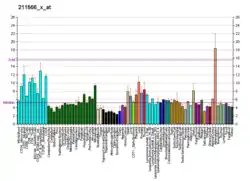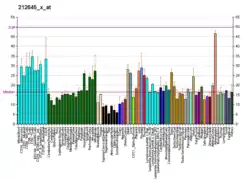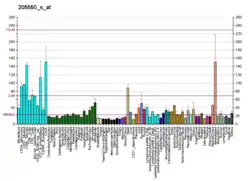BRE (gene)
BRCA1-A complex subunit BRE is a protein that in humans is encoded by the BRE gene.[5][6][7]
Repair of DNA damage
BRE, the protein product of the BRE (gene), is a core component of the deubiquitin complex BRCA1-A.[8] Other core components of the BRCA1-A complex are the BRCC36 protein (BRCC3 gene), MERIT40 protein (BABAM1 gene), and RAP80 protein (UIMC1 gene).[8]
BRCA1, as distinct from BRCA1-A, is employed in the repair of chromosomal damage with an important role in the error-free homologous recombinational (HR) repair of DNA double-strand breaks. Sequestration of BRCA1 away from the DNA damage site suppresses homologous recombination and redirects the cell in the direction of repair by the process of non-homologous end joining (NHEJ).[8] The role of BRCA1-A appears to be to bind BRCA1 with high affinity and withdraw it away from the site of DNA damage to the periphery where it remains sequestered, thus promoting NHEJ in preference to HR.
Protein-protein interactions
BRE (gene) has been shown to interact with:
References
- GRCh38: Ensembl release 89: ENSG00000158019 - Ensembl, May 2017
- GRCm38: Ensembl release 89: ENSMUSG00000052139 - Ensembl, May 2017
- "Human PubMed Reference:". National Center for Biotechnology Information, U.S. National Library of Medicine.
- "Mouse PubMed Reference:". National Center for Biotechnology Information, U.S. National Library of Medicine.
- Gu C, Castellino A, Chan JY, Chao MV (September 1998). "BRE: a modulator of TNF-alpha action". FASEB Journal. 12 (12): 1101–1108. doi:10.1096/fasebj.12.12.1101. PMID 9737713. S2CID 83491319.
- Li L, Yoo H, Becker FF, Ali-Osman F, Chan JY (January 1995). "Identification of a brain- and reproductive-organs-specific gene responsive to DNA damage and retinoic acid". Biochemical and Biophysical Research Communications. 206 (2): 764–774. doi:10.1006/bbrc.1995.1108. PMID 7826398.
- "Entrez Gene: BRE brain and reproductive organ-expressed (TNFRSF1A modulator)".
- Rabl J (October 2020). "BRCA1-A and BRISC: Multifunctional Molecular Machines for Ubiquitin Signaling". Biomolecules. 10 (11): 1503. doi:10.3390/biom10111503. PMC 7692841. PMID 33142801.
- Dong Y, Hakimi MA, Chen X, Kumaraswamy E, Cooch NS, Godwin AK, Shiekhattar R (November 2003). "Regulation of BRCC, a holoenzyme complex containing BRCA1 and BRCA2, by a signalosome-like subunit and its role in DNA repair". Molecular Cell. 12 (5): 1087–1099. doi:10.1016/s1097-2765(03)00424-6. PMID 14636569.
- Ewing RM, Chu P, Elisma F, Li H, Taylor P, Climie S, et al. (2007). "Large-scale mapping of human protein-protein interactions by mass spectrometry". Molecular Systems Biology. 3: 89. doi:10.1038/msb4100134. PMC 1847948. PMID 17353931.
- Rual JF, Venkatesan K, Hao T, Hirozane-Kishikawa T, Dricot A, Li N, et al. (October 2005). "Towards a proteome-scale map of the human protein-protein interaction network". Nature. 437 (7062): 1173–1178. Bibcode:2005Natur.437.1173R. doi:10.1038/nature04209. PMID 16189514. S2CID 4427026.
External links
- Human BRE genome location and BRE gene details page in the UCSC Genome Browser.
Further reading
- Miao J, Panesar NS, Chan KT, Lai FM, Xia N, Wang Y, et al. (April 2001). "Differential expression of a stress-modulating gene, BRE, in the adrenal gland, in adrenal neoplasia, and in abnormal adrenal tissues". The Journal of Histochemistry and Cytochemistry. 49 (4): 491–500. doi:10.1177/002215540104900409. PMID 11259452.
- Ching AK, Li PS, Li Q, Chan BC, Chan JY, Lim PL, et al. (November 2001). "Expression of human BRE in multiple isoforms". Biochemical and Biophysical Research Communications. 288 (3): 535–545. doi:10.1006/bbrc.2001.5801. PMID 11676476.
- Dong Y, Hakimi MA, Chen X, Kumaraswamy E, Cooch NS, Godwin AK, Shiekhattar R (November 2003). "Regulation of BRCC, a holoenzyme complex containing BRCA1 and BRCA2, by a signalosome-like subunit and its role in DNA repair". Molecular Cell. 12 (5): 1087–1099. doi:10.1016/S1097-2765(03)00424-6. PMID 14636569.
- Li Q, Ching AK, Chan BC, Chow SK, Lim PL, Ho TC, et al. (December 2004). "A death receptor-associated anti-apoptotic protein, BRE, inhibits mitochondrial apoptotic pathway". The Journal of Biological Chemistry. 279 (50): 52106–52116. doi:10.1074/jbc.M408678200. PMID 15465831.
- Chan BC, Li Q, Chow SK, Ching AK, Liew CT, Lim PL, et al. (January 2005). "BRE enhances in vivo growth of tumor cells". Biochemical and Biophysical Research Communications. 326 (2): 268–273. doi:10.1016/j.bbrc.2004.11.013. PMID 15582573.
- Lim J, Hao T, Shaw C, Patel AJ, Szabó G, Rual JF, et al. (May 2006). "A protein-protein interaction network for human inherited ataxias and disorders of Purkinje cell degeneration". Cell. 125 (4): 801–814. doi:10.1016/j.cell.2006.03.032. PMID 16713569. S2CID 13709685.






